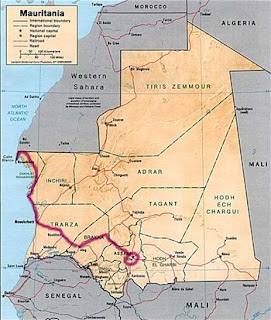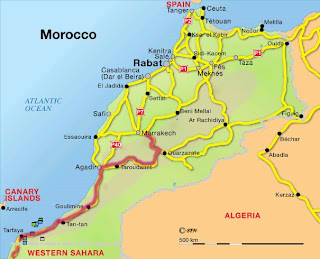Olo on helpottunut. Koko viime viikko oli helppo, vaikka tiet olivat huonoja. On ajettu ilman fyysistä työntekoa. Vain yksi henkilö on keskeyttänyt silloin alkumatkasta, muuten kaikki ovat perillä ja kohtalaisessa kunnossa. Yksi auto sanoi loppumatkasta itsensä irti ja se hinattiin perille.
Tulimme eilen tänne Grand-Popoon ja pysähdyimme tullessa jonkinlaisen julkisen rakennuksen pihaan, olisiko ollut jokin koulu. Yhtäkkiä siinä pidettiin paljon ranskankielisiä puheita. Meitä oli vastassa viisi suomalaista. Täällä toimii suomalais-afrikkalainen seura, joka oli kuullut että Sitikka-kolonna päättää trailinsa tänne. Olivat tulleet vastaan. Yhdellä heistä on Rätti-Sitikka, ja hän oli arvellut että kai trailissa joku suomalainenkin on mukana. Mukavia ihmisiä. Nämä olivat nuoria taiteilijoita, jotka ovat pari kuukautta kerrallaan täällä apurahan turvin.

Mitään koordinoidumpaa ei ollut perilletulon juhlimiseksi. Siinä “koululla” tullessa saatiin vähän snacksia - mikroskooppisen pieni pizzanpala, sitten hotellille. Päivällinen oli riisiä ja kanaa tai lammasta, ei erityistä juhlaruokaa, ihan vaatimatonta.
Tänään jaettiin palkinnot ja otettiin valokuvat, kohta on päivällisen aika. Me sijoituimme loppupään kieppeille, 16:nneksi. Emme tehneet kovin hyvin kaikkia tehtäviä, kun tuo ranska ei oikein taivu. Ei saatu miinuspisteitä mutta ei plussiakaan.
Edellisenä yönä käytiin matkan varrella Abomeyssä, joka on entisen Beninin, Dahomeyn, pääkaupunki. Se alue on woodoo-uskonnon syntysijoja. Ympäristö oli kiva. Kävimme jossakin syrjäseudulla seuraamassa myös woodoo-menoja. Mopot toimittivat taksin virkaa, ja siinä mentiin mopon takaritsillä takamaille. Fiilis oli kyllä autenttinen. Jos olisi ollut yksin, olisi pelottanut, mutta kun isolla joukolla mentiin, oli hauskaa.
Woodoomenot olivat kesynoloista odotuksiin nähden, lähinnä musiikkia ja tanssimista ja mörköasuisia ihmisiä. Odotin enemmän katkaistuja kauloja ja kananreisiä ja sen sellaisia uhrimerkkejä, mutta sellaista ei näkynyt. Enkä löytänyt mistään woodoo-nukkeja, vaikka etsin; nukkerituaalit eivät kuulu alkuperäisuskontoon, nekin ovat muiden keksimää legendaa. Musiikki, tanssi ja woodooasut edustavat alkuperäistä uskontoa. Woodoo on täällä Beninissä melkoisen voimakas valtauskonto.
Juhan kanssa sooloiltiin hieman, ajoimme Togon puolelle, ja huomasimme että ei siellä erilaista ollut. Kristinusko on siellä kovempi sana kuin täällä. Togon-vierailu jäi pistäytymiseksi, sillä rajalla häslättiin noin puolitoista tuntia per suunta.
Huomenna on meno pääkaupunkiin. Siellä otetaan Trailin ryhmäkuva. Viimeinen yö vietetään Sheraton-hotellissa, sitten pakataan autot laivaan ja lähdetään sunnuntai-iltana myöhään lentäen kohti Eurooppaa. Lontoosta lennetään sitten Ryanairilla Suomeen. Autot tulevat Eurooppaan tammikuun toisella viikolla, jos laiva lähtee tämänhetkisen tiedon mukaan.
Tapasimme erään kolmikymppisen belgialaisen, joka oli ensimmäisellä seikkailumatkallaan ja mietti kovasti miltähän tuntuu palata kotiin sellaisen kokemuksen jälkeen – niin erilaista on kaikki ollut. -Minusta on mukava tulla kotiin. Kaikki on mennyt hyvin mutta mukava on lähteä.
“Matkat ovat aina sopivan mittaisia.”
Oma mottoni - pitää paikkansa.
- - - -
Here we are – in Grand-Popo, at the destination
This place is quite miserable, we wondered why the trail ends here. Some kind of a village there is, houses here and there along the coast. We are living now in a passable hotel; it's not any tourist hotel but pleasant and modest.
The feelings are relieved. All the last week was easy, even though the roads were bad. We have driven without any physical effort. All the teams and cars are at their destination, in quite good condition. Only one man had to stop on the first part on the trail, and one car broke down in the last part and it was towed to the destination.
Yesterday, we came here to Grand-Popo, and stopped in the yard of a public building, a school maybe. Suddenly there were lots of speeches in French. We were gladly surprised when we met five Finns waiting for us. They had heard about the Trail finishing in Grand-Popo, and thought that there must be at least one Finn among the Sitikka-trailers. Those people were young Finnish artists who are working with a stipend for five months at a time, in the Finnish-African society. Nice people, indeed.
There have not been any coordinated activities because of the end of the Trail. We got some snacks when stopping at the "school" – a microscopic bit of pizza, then to the hotel. The supper was rice and lamb or chicken, nothing 'feasty', just trivial.
Today we got the prizes and they took the photos. Soon we will have a dinner. Our ranking was 16th. We did not performed well in the given tasks, because of the lack of French. We got no minus points but no plus points either.
The night before, along the way, we visited Abomey, which is the capital city of Dahomey, previously Benin. This region is the birthplace of the native religion of Benin, voodoo. The environment was really nice. We drove on the back racks of the mopeds, which served as the taxis there, somewhere to the backwoods to participate in the voodoo rite. Feelings were really authentic - being alone driving on the moped rack in the dark it would have been scary, but with mates it was just fun.
My expectations about the voodoo rite were a bit different from the way it turned out. There were not any cut necks or chicken legs or any bloody thingies, nor any voodoo puppets – I tried to find some. These things people have just imagined to be a part of the voodoo rites. The music and dancing in the bugbear clothing is what we experienced, and that is the real thing.
With Juha we did a solo activity and drove to Togo. It was a real popping-out trip, because we had such a fuss in crossing the frontier in both directions. It was just similar in Togo, only that Christianity seemed to be stronger there than in Benin.
Tomorrow we will drive to the capital city. There they will take the group photo of the Trail. We shall stay overnight in the Sheraton hotel. Then we will pack the Sitikkas into the ship and start homeward bound in the evening on Sunday.
As I said on Tuesday - "The extent of the journey is always suitable" – my motto, that's a fact.













